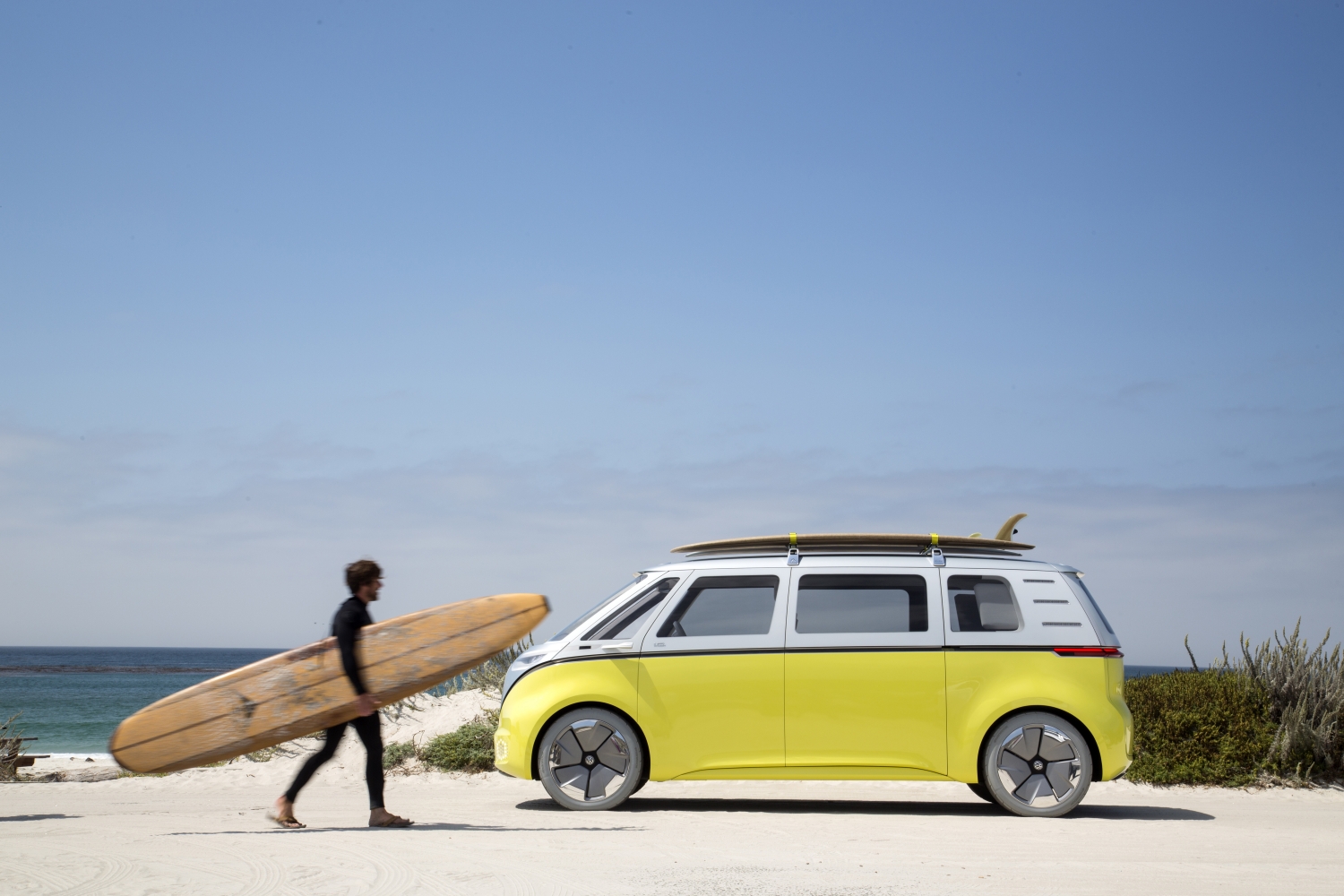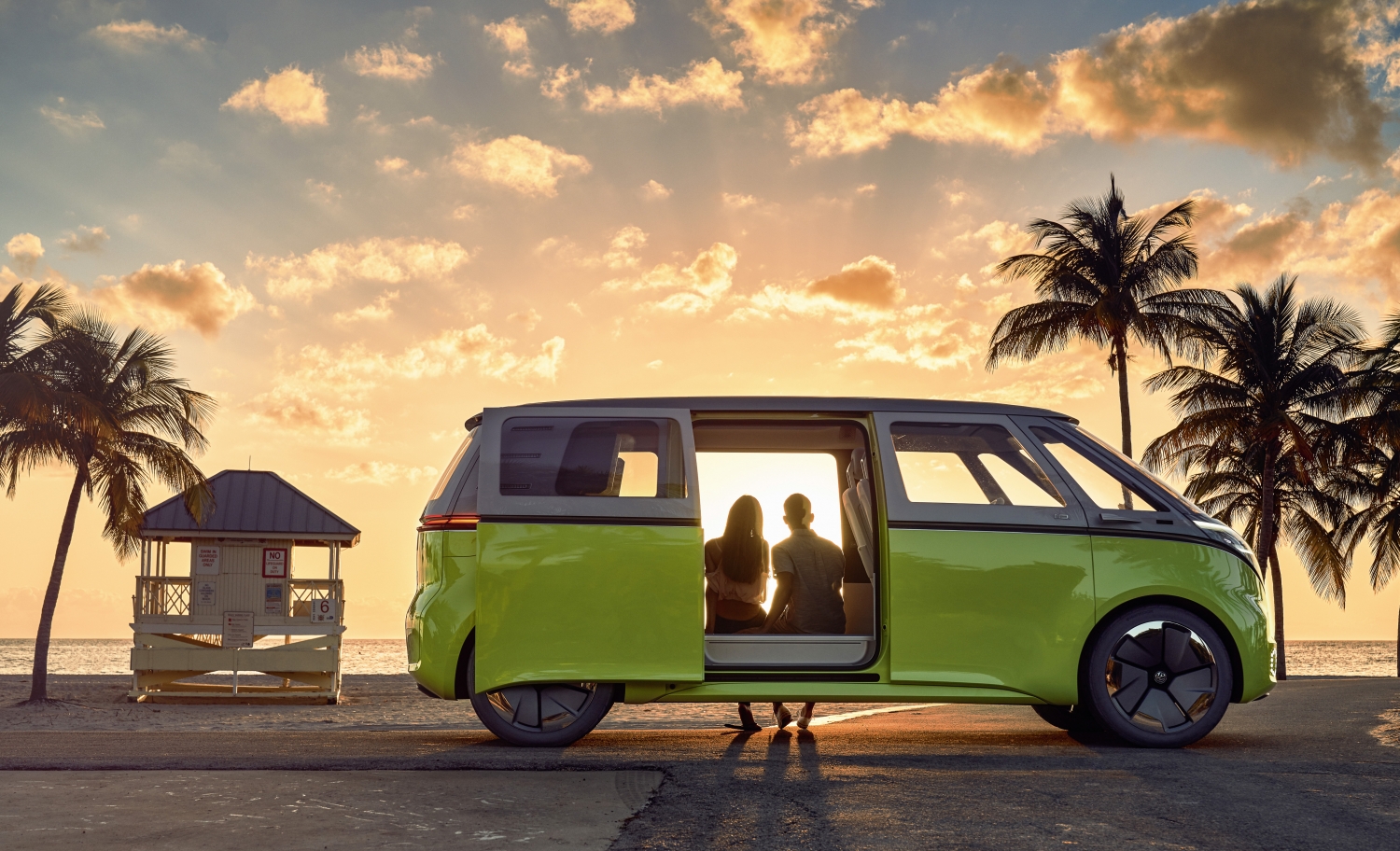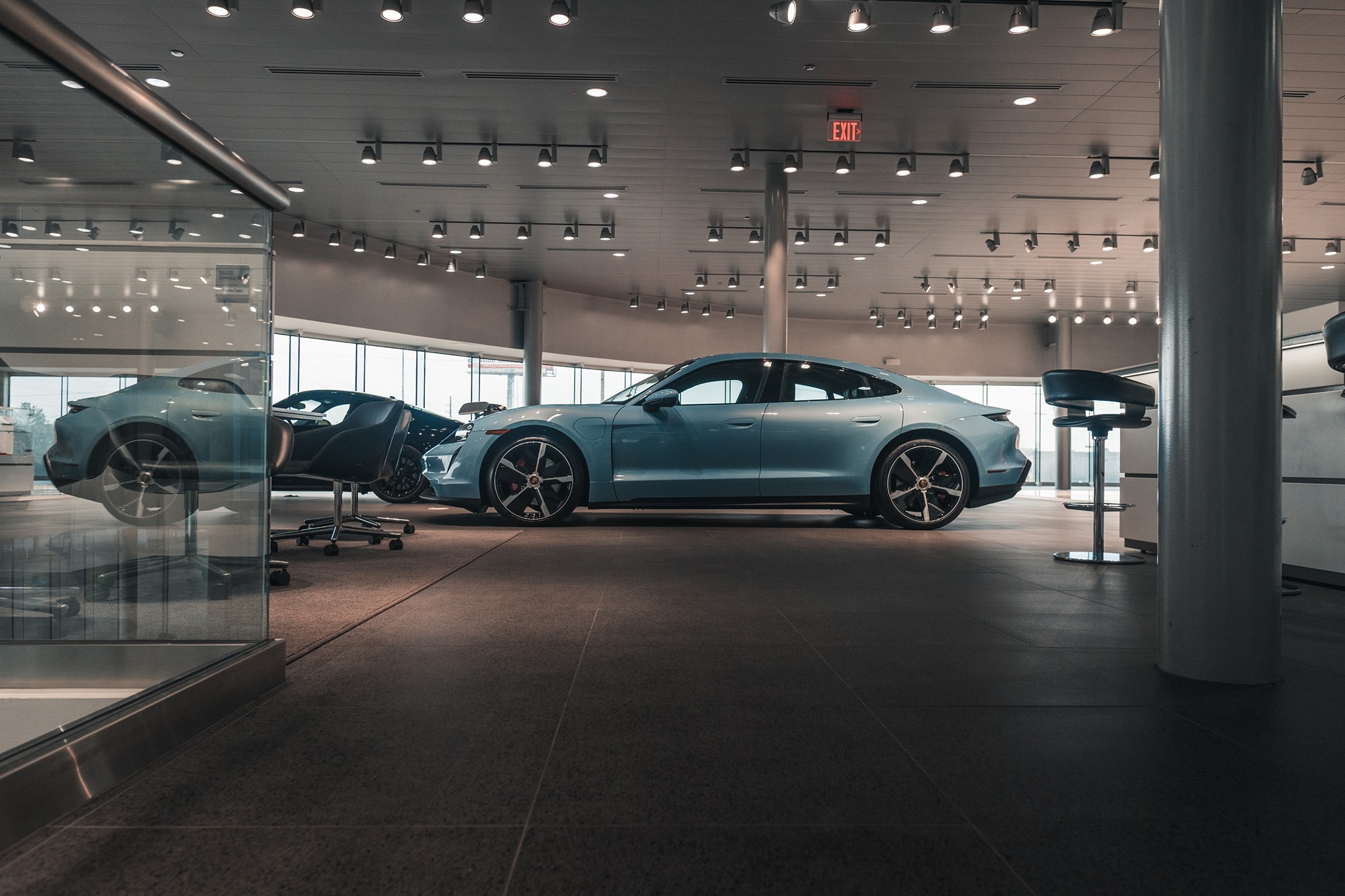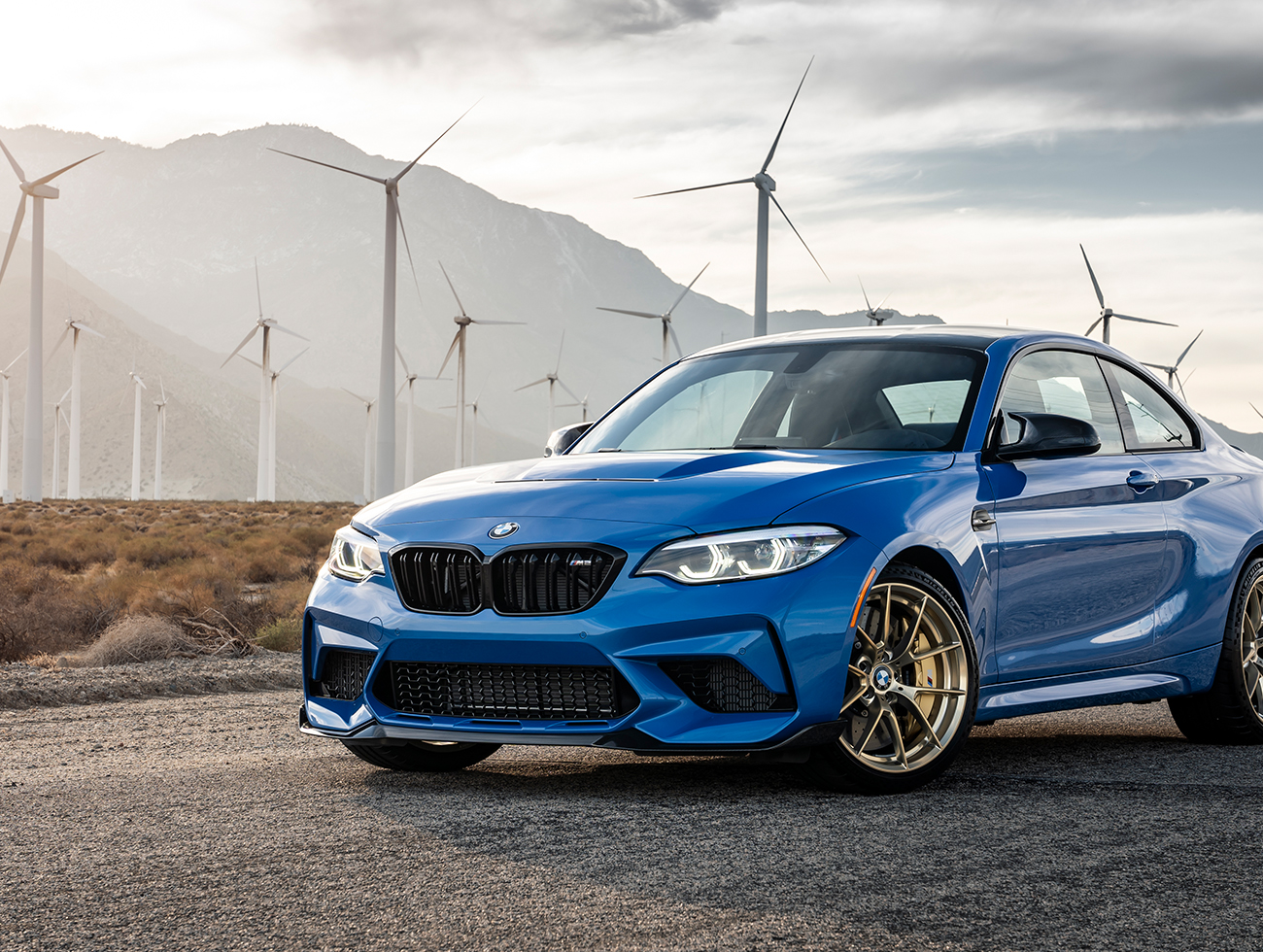As VW Gets Ready to Introduce the 7th Generation of its Iconic Microbus – the ID. Buzz We’ll Take a Look at its Rich History
It’s an iconic symbol of an entire generation, right up there with bellbottoms, peace signs and daisies.
In the 1960s, much like LSD and psychedelic rock, the Volkswagen Bus became a symbol of the counterculture and a means for helping the younger generation “turn on, tune in and drop out” as Harvard psychologist Timothy Leary so aptly put it.
Hippies loved their microbuses and painted them with peace signs, swirling colors and flowers. As they rolled into protests, rock concerts, be ins and love ins, these rolling works of became symbols of the anti-establishment.
Volkswagen started manufacturing the Microbus in 1950. Known as Type 2, the Microbus was a close cousin of the VW Beetle, which was named Type 1. After World War 2, the German automaker was looking to expand its product line by creating a vehicle that would capture the attention of the car buying public. It was, in essence, the first van or minivan because before the microbus, people had used only large cars, trucks and buses to haul around people and cargo.
Last year, the VW Microbus marked its 70th anniversary as both an iconic vehicle and as a durable mode of transportation.
(Motor Trend Magazine)
The microbus design was actually created by Ben Pon, a Dutch importer of VW Beetles, according to Motor Biscuit website. He designed the bus in 1947 after a visit to the Volkswagen plant where he saw a flatbed parts-hauler that was made from a Type 1 chassis.
It took a few years for the company to roll out the new vehicle but eventually the first VW Type 2 bus went into production in 1950. That year, VW made just 9,500 buses, which sold quickly. At the time two versions were offered: the Kombi, with side windows and removable middle and rear seats, and the window-lacking Commercial, essentially the first known panel van.
The VW bus was promoted for work and play but VW stopped short of calling it a bus or a van, instead using the term “station wagon” in marketing for better mass appeal.
Consumers loved that the little VW bus could move kids and cargo, employees and camping gear. They also loved that it was easy to operate and maintain, providing a cost-effective alternative to the ever-popular station wagon.
People soon started customizing the vans into “campers” with beds and sinks. WV took note of the customizing craze and teamed up with Westfalia, a German company known for building carts and wagons, to make camper conversion kits. The first VW Westfalia campers were exported to the United States in 1956.
As the revolution of the 1960s progressed, the VW bus was being used to transport people to rallies, polling stations and protests – so much so that by the end of the decade it became known as the “hippie van.”
And it did all of this with the engine of a VW bug.
The VW microbus was essentially Volkswagen Beetle with a van body placed on top of the foundation. It shared the Beetle’s 1.1-liter air-cooled engine, rear-mounted engine and transaxle. But it had a ladder-frame chassis and gear-hub reduction boxes to lower the gearing across all four gears, according to Auto Trends Magazine.
The microbus’ original engine produced a mere 25 horsepower. That was increased to 44 horsepower when a 1.5-liter engine was introduced, according to the magazine. Fuel mileage for first- and second-generation models was about 20 mpg with top speeds ranging from 55 mph for earlier models to 68 mph for second-generation models.
The first-generation Microbus featured design characteristics that were unique to this model, according to Auto Trends website. These included that split aerodynamic windshield and some window variations. Standard models were equipped with 11 windows, Deluxe versions had 15 windows and Sunroof Deluxe models added eight small skylight windows for a total of 23 windows, according to Auto Trends. The first models also had removable middle- and rear-row seats, while later models had only a removable rear seat.
After the original model’s 18-year run, the second-generation Volkswagen Microbus was unveiled, minus the split windshield, which was replaced by a single wraparound window. The window count dropped as well with only vent, side, sliding and rear windows featured. At that point a 1.6-liter four-cylinder engine making 47 horsepower and paired with a four-speed manual or a three-speed automatic transmission was offered.
Later on, a 1.7-liter four-cylinder engine making 65 horsepower was introduced, but imports to the United States were soon ended, according to Auto Trends. Volkswagen continued to manufacture the Volkswagen Microbus after leaving the US market, building the vehicle at plants located in Germany, Argentina, Brazil, Mexico, and Australia.
A third-generation model was introduced in 1980, sold briefly as the Vanagon in the United States before high tariffs ended imports. By 2009 only the Brazilian plant was manufacturing the van and that model was based on the second-generation design with a water-cooled engine.
After 78 consecutive years of building the rear-engine buses, VW announced the end of the Brazilian-manufactured Kombi. New environmental legislation had effectively killed the model.
VW bus and production stopped in 2014.
But… get ready for the comeback! The VW bus is about to return in 2022 as an electric vehicle.
Currently known as the ID. Buzz, the newest version of the VW Microbus will offer 369 horsepower from electric motors on each axle. The original 1950 Type 2 sold in the United States had a mere 30 horsepower, making it very slow driving up hills.
When VW announced the new bus, standing beside VW Chairman Herbert Diess was Ben Pon Jr., whose father Ben Pon Sr., was the first VW importer for the American market and the man who sketched the rough outline of the new bus on a napkin during lunch one day in 1947.
“It took you everywhere with your friends, it was a car but also a home on wheels, it was both reliable and unconventional, it was highly emotional,” says Diess. “It was and still is a wonderful car.”
The new I.D. Buzz will be the seventh generation of the microbus. The vehicle has evolved into a high-tech electric vehicle but maintains a lot of its charm in terms of design and, well, cuteness.
It may be a far cry from the hippie buses of the 1950s – it’s unlikely anyone is going to want to paint up the exterior with psychedelic graffiti – but the new VW Microbus is poised to be a huge hit worldwide. After all, what other car is so beloved by so many people?
The napkin on which the original VW van design was drawn is now on display in an Amsterdam museum. The vehicle itself went on to attain icon status worldwide thanks to its compact body, spacious interior, and two-tone color scheme. It was “one of our most beloved cars,” Diess noted.
Now, thanks in part to the impending comeback, the rest is history. And it’s also the future. Fully electric, Filled with Tech. Ready to turn off, plug in and pull away.
—————————
Interested in buying a Volkswagen? For more information about possible launch dates of the ID. Buzz contact our VW Marin dealership or browse through our VW inventory.
















